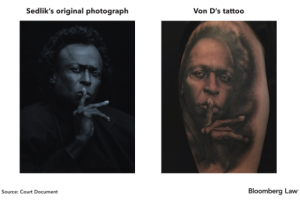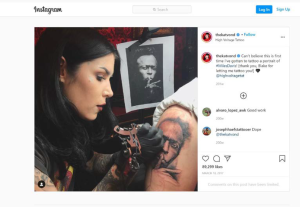Following the Supreme Court decision in Andy Warhol Foundation for the Visual Arts v. Goldsmith in 2023, we published a blog titled “The Supreme Court’s Decision in Warhol v. Goldsmith: Interpreting Copyright Fair Use.” In that blog, we discussed the concept of Fair Use in the copyright context while also highlighting the key facts of the Warhol decision which we recommend reviewing prior to continuing to read this blog, if you need a refresher. We are revisiting this topic as a new case has been revived due to the precedent set by the Supreme Court, a case that involves a portrait of the acclaimed jazz musician, Miles Davis, which was taken by a Los Angeles-based photographer and used by a celebrity tattoo artist as the reference photo for a tattoo.
As a quick refresher, the term Fair Use is often mentioned in relation to the use of portion of a copyrighted material for purposes such as criticism, comment, news report, teaching, scholarship or research. When used for such purposes, the court has generally held that unauthorized use of the copyrighted material is not considered infringement as long as the use does not fail the four-factor test described in more detail in our previous post. The most scrutinized factor of the four-factor test is commonly referred to as the transformative use test which seeks to determine whether the use of the copyrighted work in question transformed the purpose and character of the work into something else, such as parody or commentary. In the Warhol case, Andy Warhol was commissioned by Vanity Fair to create a cover for the magazine’s story on the artist Prince. Andy Warhol was given a portrait of Prince taken by a rock-and-roll photographer, Lynn Goldsmith, for use as a reference photo under a license between Lynn Goldsmith and Vanity Fair. The license stipulated that Andy Warhol could use the photo for one time only and Lynn Goldsmith was paid $400. Andy Warhol, without executing additional license agreements, created 15 additional works using the reference photo. Importantly, one of these works by Andy Warhol was later licensed to Conde Nast for the specific purpose of using the work in a magazine article about the artist Prince. This use of Andy Warhol’s Prince artistic work, was ultimately the basis for the Supreme Court’s determination that Fair Use was not applicable due to the lack of transformative use. The fact that Andy Warhol used his artistic abilities to alter the reference photo was not transformative because the purpose and character of the unauthorized use was identical to the original – authorized – use of the reference photo: depicting Prince in a magazine story about Prince.
The above summary was intended to refresh the Fair Use discussion in the context of a well-known artist as this fact pattern as once again emerged in the case of Jeffrey Sedlik v. Katherine Von Drachenberg (aka Kat Von D). The facts of this case are pretty straightforward: Sedlik is a professional photographer and a professor who created and owns the copyright to a photographic portrait of the famous jazz musician, Miles Davis, that was created in 1989 and first published in JAZZIZ magazine in that same year (copied below and used under the Fair Use exclusion of commentary). This photo has been featured in magazines around the world and was featured in Life magazine’s annual “Picture of the Year” issue. Sedlik has sold licenses to the portrait which authorized reproduction, distribution, and display of the portrait for commercial and non-commercial purposes since it was created.
 The other party to this case, Kat Von D, is well known in certain circles as a world-renowned tattoo artist who has appeared in various reality TV shows and magazines which can be found on her personal website. According to the complaint, Kat Von D is also a recording artist, TV and film producer and owns and operates a tattoo parlor, an art gallery, a cosmetic company, a clothing company, and a shoe company, all of which have earned her 7.4 million followers on Instagram and 12 million followers on Facebook. In 2017, Kat Von D used the Miles Davis portrait, without Sedlik’s authorization, to create a reproduction of the image in the form of a tattoo on the arm of friend whom she did not charge for the service. She featured the portrait and her work tattooing the portrait on her social media channels which Sedlik claims was done to promote and solicit the sale of goods and services of Kat Von D and her various commercial brands, as seen in the image below which was taken from the complaint.
The other party to this case, Kat Von D, is well known in certain circles as a world-renowned tattoo artist who has appeared in various reality TV shows and magazines which can be found on her personal website. According to the complaint, Kat Von D is also a recording artist, TV and film producer and owns and operates a tattoo parlor, an art gallery, a cosmetic company, a clothing company, and a shoe company, all of which have earned her 7.4 million followers on Instagram and 12 million followers on Facebook. In 2017, Kat Von D used the Miles Davis portrait, without Sedlik’s authorization, to create a reproduction of the image in the form of a tattoo on the arm of friend whom she did not charge for the service. She featured the portrait and her work tattooing the portrait on her social media channels which Sedlik claims was done to promote and solicit the sale of goods and services of Kat Von D and her various commercial brands, as seen in the image below which was taken from the complaint.
When the case was initially brought before the court, the Andy Warhol case was not yet decided and the judge initially ruled for Kat Von D in a summary judgement decision but paused the proceeding until the Supreme Court rendered its opinion on the Warhol matter. Following the Supreme Court holding, the stay was lifted and the lawsuit was set for trial based on the Supreme Court’s opinion on the transformative use, or lack thereof, in the Warhol case. The trial for this case is set to begin in early 2024 in the United States District Court for the Central District of California and poses a number of interesting questions about the reach of copyright Fair Use under the new precedent established in the Warhol decision. While we will have to wait and see the final outcome of this case, there would be material impacts on various industries such as the tattoo industry, and perhaps even on generative AI. In the tattoo industry, use of copyrighted reference photos is common and has largely continued without disruption due to the costs of litigation compared to the typical damages for copyright infringement and the difficultly is placing a value on the personal display of an infringing work on the body of the person displaying said work. More broadly, when viewing this issue through the lens of visual works created through generative AI based on training models using copyrighted works without license, the growing body of legal decisions following the Warhol decision by the Supreme Court may pose a barrier to the field as these AI tools generate countless derivative works that may be violating the Fair Use conditions. We will keep a close eye on the trial in this case and provide an update to the blog series as the trial progresses.


